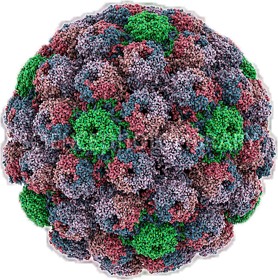Research interests
Our research interests surround simian virus 40 (SV40), a small, non-pathogenic double-stranded DNA virus. Our research interest is to understand cellular processes at the molecular level and apply the knowledge for the development of medical applications.
Basic Biological Research
The basic biological research encompasses investigations on SV40 cell entry and cellular signaling. Upon infection SV40 elicits multiple signaling in the host, which facilitate its endocytosis, intracellular trafficking and propagation. We specifically focus on signaling induced by the viral capsid proteins prior to nuclear entry of the viral genome and viral gene expression. We found that upon infection SV40 elicits complex signaling networks, including pro-apoptotic signaling and survival pathway. Intriguingly these two opposing pathways are robustly balanced, as the cells neither apoptose nor proliferate. Regulation of this balance is our major interest, presently under investigation.
Basic Biophysical Research
We are interested in the assembly of the SV40 capsid in vivo, during viral propagation, and in vitro, in the test tube. We found that assembly in vitro requires a polymeric scaffold, and the size of the formed capsid depends on the size and nature of the scaffold, which may be DNA, RNA or another polymer. Empty virus nanoparticles may be formed by expressing the major viral capsid protein in insect cells.
We also study the properties of the virus, and empty nanoparticles, in response to changes in the external environment.
Medical Applications
Beginning with studies towards the development of SV40 as a gene therapy vector in the Eighties, we continued, in the Nineties, through developing a safe viral vector that would be assembled in vitro around plasmid DNA of choice. Experiments in animal models demonstrated that the empty capsids, without any enclosed DNA, function significantly better than the gene therapy vector containing the plasmid of choice! Since that discovery our studies are focused on the therapeutic properties of the empty capsids, SV40 nanoparticles (NPs). So far we focused on two severe diseases, that have no therapy except for mechanical support (and antibiotics when relevant) in intensive care units: acute kidney injury and sepsis. We found that the NPs significantly improved survival in pre-clinical models for both. The underlying mechanisms is through the activation (and suppression) of genes and pathways. Interestingly the genes and pathways activated for each of those diseases are widely different. Our recent sepsis study demonstrated that the pathways elicited by the NPs were associated with many biological functions, including immune response, anti-pathogenic pathways, regeneration, morphogenesis and homeostasis. Furthermore, the affected genes and pathways were modified with time, along the progress of the disease and recovery process. Significantly, when administered to control healthy rats, the NPs induced negligible changes in gene expression. Presently we continue to develop this reagent towards a therapeutic agent. We propose that the NPs acquired these fascinating properties during virus-host coevolution, selected for the "selfish goal" of the virus to propagate in a healthy host. In parallel we strive to understand the biological mechanism that facilitates this extraordinary property.

